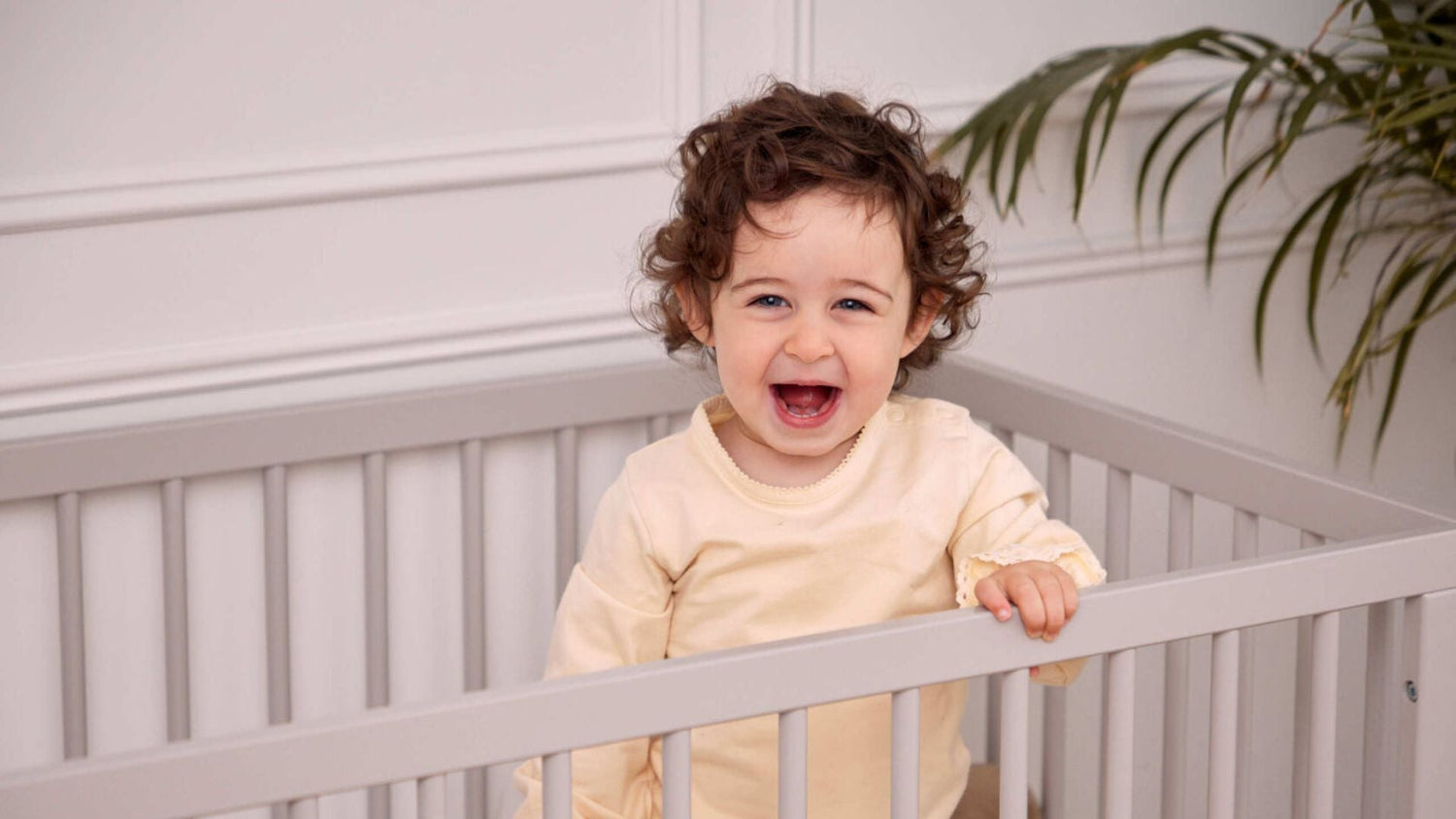As a parent, getting your baby to sleep in their crib can sometimes feel like a daunting task. Whether you’re transitioning from contact naps, co-sleeping, or getting a newborn settled, finding the right approach is key to creating healthy sleep habits. In this blog, we'll explore practical tips for each stage and situation, making crib time a smoother experience for both you and your little one.
Scroll through the blog or jump immediately to the section you need:
How to Transfer Baby to a Crib
How to Get a Newborn to Sleep in a Crib
How to Get Your Baby to Sleep in Crib After Co-Sleeping
How to Get Baby to Sleep in a Crib Instead of Your Arms
How Long Can a Baby Stay in a Next to Me Crib
How to Transfer Baby to a Crib
Transitioning your baby from another sleeping arrangement, like a bassinet or your arms, to a crib can be tricky. Here’s how you can make that move easier.
- Start with naps: If you’re wondering how to get baby to nap in the crib, begin by putting your little one down for daytime naps in the crib. This helps them get used to the new space while they’re not overly tired, making the transition less stressful.
- Gradual transition: Try transferring baby to a crib gradually. You could start with one sleep a day in the crib, and then slowly increase this over time until all sleeps are in their own bed.
- Create a familiar environment: One of the best strategies for how to transition baby to a crib is to make the crib feel familiar. Using the same sleep sacks, white noise, or even a swaddle that your baby associates with sleep can help them feel more secure in the new space.
The Baby Elegance Kangu Foldable Crib is an ideal solution for parents looking to help their baby transition to sleeping in a crib by offering a portable, cosy napping space anywhere in the house. Its lightweight, foldable design makes it easy to move from room to room, allowing your baby to nap comfortably in different environments throughout the day. This helps your little one grow accustomed to sleeping in a crib-like setting, no matter where they are, easing the overall transition to their full-sized crib. The breathable mesh sides and soft mattress ensure a safe, snug spot for naps, promoting restful sleep while maintaining a familiar, secure environment.
How to Get a Newborn to Sleep in a Crib
Newborns are often used to the warmth and closeness of being held, making it challenging to settle them in a crib. Here’s how you can help them adjust.
- Swaddle or sleep sack: If you’re asking how to get a newborn to sleep in a crib, consider swaddling or using a sleep sack to recreate the comforting sensation of being held. This helps them feel snug and secure, even in the crib.
- Focus on soothing: When figuring out how to settle a newborn in a crib, aim to create a calm, soothing environment. Dim lights, soft sounds, and gentle rocking before bedtime can signal that it’s time to sleep.
- Place baby down drowsy but awake: A great tip is to lay them down while they are drowsy but still awake. This helps them learn to fall asleep independently, which can lead to longer and more restful nights.
How to Get Your Baby to Sleep in Crib After Co-Sleeping
If your baby is used to co-sleeping, transitioning them to their own crib can be challenging. Here are a few steps to help with this process.
- Create a bedtime routine: Start by establishing a consistent bedtime routine. Bath, storytime, and cuddles can help signal to your baby that it’s time to wind down and sleep.
- Use a gradual approach: Many parents successfully transition from contact napping to crib by slowly increasing the amount of time their baby sleeps in the crib. You could start by placing your baby in the crib for naps before moving on to nighttime sleep.
- Stay consistent: It can take a few days or weeks for babies to adjust to sleeping in a crib after co-sleeping, but consistency is key. Gently reassure your baby if they wake, but aim to keep them in the crib to reinforce the new sleep routine.
The Baby Elegance Co-Glide Electric Bedside Crib is a fantastic tool to help parents transition their baby from co-sleeping to sleeping independently in a crib. With its smooth, electric glide function, the Co-Glide mimics the gentle rocking motion that babies find soothing, making it easier for them to settle. Its adjustable height and ability to sit right next to the parent’s bed provide the closeness babies are used to in co-sleeping, while still giving them their own safe space. This gradual separation can help babies feel secure as they transition to sleeping in their own crib, fostering healthy sleep habits over time.
How to Get Baby to Sleep in a Crib Instead of Your Arms
Many babies love the comfort of sleeping in their parents' arms, but there comes a time when you’ll want them to sleep in their own crib. Here’s how to manage that transition.
Put baby down drowsy: The key to how to transfer baby from arms to crib is timing. Wait until your baby is sleepy but not fully asleep before placing them in the crib. This helps them associate the crib with comfort and sleep.
Use soothing techniques: Try placing them in the crib while using soothing techniques like gently patting or shushing to reassure them. This can help your baby adjust to the new sleeping space while still feeling comforted.
Stay patient and persistent: Babies may protest initially, but with time, they will grow more comfortable sleeping in their crib. If your baby wakes after being transferred, you can offer gentle comfort without picking them up to reinforce the crib as their sleep spot.
How Long Can a Baby Stay in a Next to Me Crib
Next to me cribs are a popular choice for new parents, but there’s often confusion around how long can a baby sleep in a next to me crib. Let’s clarify when it’s time to make the switch.
- Size and mobility: Most babies can comfortably stay in a next to me crib for up to six months, but it depends on their size and mobility. If you’re wondering when is baby too big for a next to me crib, it’s usually when they can roll over or push up on their hands and knees.
- Weight limit: Always check the manufacturer’s guidelines for your crib. Your crib’s weight limit can provide an additional clue as to when your baby will need to move to a larger sleeping space.
- Time for the transition: If your baby is outgrowing their next to me crib, start introducing them to a standard crib for naps and gradually transition to it for overnight sleep. This will help ease the switch when they outgrow their smaller space.
FAQ
It’s best to set up the next to me crib before your baby arrives so that you’re fully prepared. Aim to have it ready in your third trimester.
To keep your baby safe, avoid loose blankets in the crib. Opt for a sleep sack or swaddle instead to prevent any suffocation risks.
It’s a good idea to have at least three to four crib sheets so you always have a fresh one ready when others are in the wash.
Cleaning your next to me crib regularly is essential for maintaining a safe and hygienic sleep environment for your baby. Always begin by checking the manufacturer’s care instructions to ensure you follow any specific cleaning guidelines. In most cases, you can start by wiping down the crib frame with a damp cloth and mild, baby-safe detergent to remove dust, dirt, and spills. Make sure to clean any crevices or moving parts carefully, as dust can accumulate in those areas.
For the mattress, remove the cover and wash it in the washing machine according to the fabric care instructions—usually with a gentle cycle and mild detergent. Allow it to air dry completely before reassembling the crib. If the mattress itself has a waterproof layer, you can wipe it down with a damp cloth as well, but avoid soaking it to prevent moisture buildup. Additionally, you may want to vacuum the mesh sides of the crib to clear away any dust or debris, ensuring optimal air circulation for your baby’s comfort. Regular cleaning will help prevent the buildup of allergens and maintain a healthy space for your little one.
Conclusion
By following these tips, you’ll be well on your way to creating a comfortable, safe sleep environment for your little one. Whether you're dealing with a newborn or transitioning an older baby, with patience and consistency, they’ll be happily snoozing in their crib in no time!








